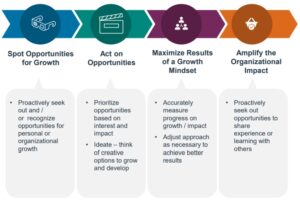Operationalizing a Growth Mindset to Succeed in the Never Normal
We now live and work in a time where the new normal is the never normal. The volatility, uncertainty and ambiguity associated with this environment can present significant challenges for business leaders. It can also present endless opportunities for new sources of business value. A growth mindset is critical to success.
Growth mindset is a concept developed by psychologist Carol Dweck in her research on achievement and success. It refers to the belief that abilities and intelligence can be developed and improved through dedication, hard work, and learning. People with a growth mindset embrace challenges, persevere through obstacles, and view failures as opportunities for growth. In contrast, individuals with a fixed mindset believe their abilities and intelligence are static traits that they can’t change.
In a business environment, people with a growth mindset are often described as those who:
- Embrace challenges
- Are open to new ideas and ways of doing things
- Maintain a positive mindset even when faced with obstacles
- Learn from failures
Developing a growth mindset requires one to identify negative or limiting thoughts and reframe them into opportunities. To truly capitalize on a growth mindset, people must be able to move to action – to operationalize their growth mindset.

Operationalizing a growth mindset starts with being able to spot opportunities for growth. Growth can be associated with personal development. It can also be different ways of delivering value to your customers, new ways of working as a team, or even identifying new ideas to improve the performance of your organization.
While spotting opportunities for growth is critical, not all opportunities are created equally. The second step in operationalizing a growth mindset involves determining which opportunities to act on. Prioritizing opportunities based on what can have the most significant impact is key. Once the highest priority opportunities are clear, it’s time to brainstorm how to act. Applying creative thinking techniques can help identify new and unexpected ideas that will maximize the impact.
As ideas are put into action, it’s important to monitor and measure the results. If results or outcomes are different than anticipated, it may be time to try a different approach or even stop and move on to another opportunity.
The final step to operationalize a growth mindset is looking for ways to amplify successes by sharing with others. Think of others who may benefit from trying the same thing or learning from mistakes.
Following the steps to operationalize a growth mindset will result in improved personal, team and organizational results.
For more insights on how to develop and operationalize a growth mindset in your organization, please reach out to us at learn@horn.com.
 About the Author
About the Author
Michelle Moore is the Managing Director at HORN. Michelle has over 25 years of global experience, working with organizations to use human capital to solve complex business challenges, and with individuals to maximize personal effectiveness and career success. She has expertise across a broad range of industries, and specialized knowledge regarding innovation and digital transformation.
About HORN
We transform cultures and capabilities by better customizing solutions to the specific needs and context of our clients’ businesses and people. Our mission is to provide transformative organizational solutions and unforgettable personal learning that profoundly shifts how people think, work and lead.
For over thirty-five years, we’ve been catalysts in advancing the thinking, behavior and performance of thousands of leaders across six continents, 48 countries and every major industry. Learn more at www.horn.com.

